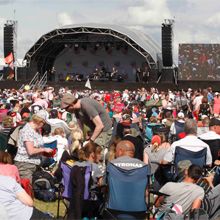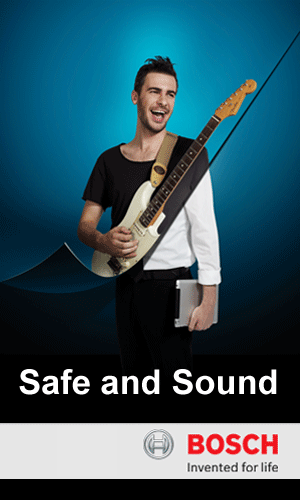 |
| The enclosures were driven by TG-7 and TG-5 power amplifiers from Electro-Voice |
The English county of Northamptonshire played host to one of the highlights of the international motor racing calendar: the British Grand Prix from Silverstone. A race with a rich tradition, it was here in 1950 that the first ever Formula One world championship was staged. This year’s event was followed not only by millions worldwide on television but also by the 120,000-plus motor racing enthusiasts that made the pilgrimage to the now legendary “Home of British Motor Racing”. They didn’t regret their journey for a couple reasons: firstly because they bore witness to a home win by Lewis Hamilton, and secondly because of the superb fringe program on site. As in previous years, several acts took to the stage in 2014 to entertain race-goers. The cherry on the cake was the performance of the headline act: the English group, Kaiser Chiefs.
Due to the organisers’ satisfaction with the sound reinforcement solution employed in recent years, line-array loudspeaker systems from Electro-Voice were deployed once more in large numbers. To the left and right of the stage, 36 XLC DVX elements with FIR-Drive delighted the audience with powerful and transparent sound. In all, 24 Xsub bass units provided a rock-solid foundation in the low frequency range. The enclosures were driven by TG-7 and TG-5 power amplifiers from Electro-Voice, Electro-Voice XW15A wedges were on monitor duty to ply the artists (including Kaiser Chiefs vocalist Ricky Wilson) with first-class foldback on stage. Two Dynacord XA2 stacks driven by Xa 4000 system power amplifiers supplied side fill.
The infrastructure for the sound equipment was provided by Freeman, who’s Group Project Director, Paul Goodall, explained: “The most interesting aspect of this year’s solution was that, thanks to an OMNEO network, we were able to operate almost entirely on the digital plane. That saved us an enormous amount of time and expense laying cables. The use of an OMNEO network had the further advantage of rendering the system unbelievably reliable throughout the entire event.”
The signals were converted to digital format by the stage box and routed to a NetMax N8000 digital matrix equipped with DM-1 Dante audio cards. From there, they were distributed through an OMNEO network. “This year, we had only digital desks at the FOH and monitor positions,” adds Goodall. “We used the NetMax inter alia to switch between the mixers of the individual performers. In this way, we could route the outputs of all the various bands’ desks directly to the PA and monitor systems without any need for a further desk. That was also an enormous advantage from the standpoint of sound quality. It meant the signals did not have to be converted from analogue to digital and back several times but remained entirely on the digital level. The sound, as a result, was far clearer – above all, in the midrange.”




